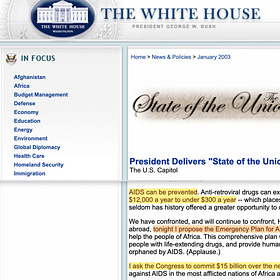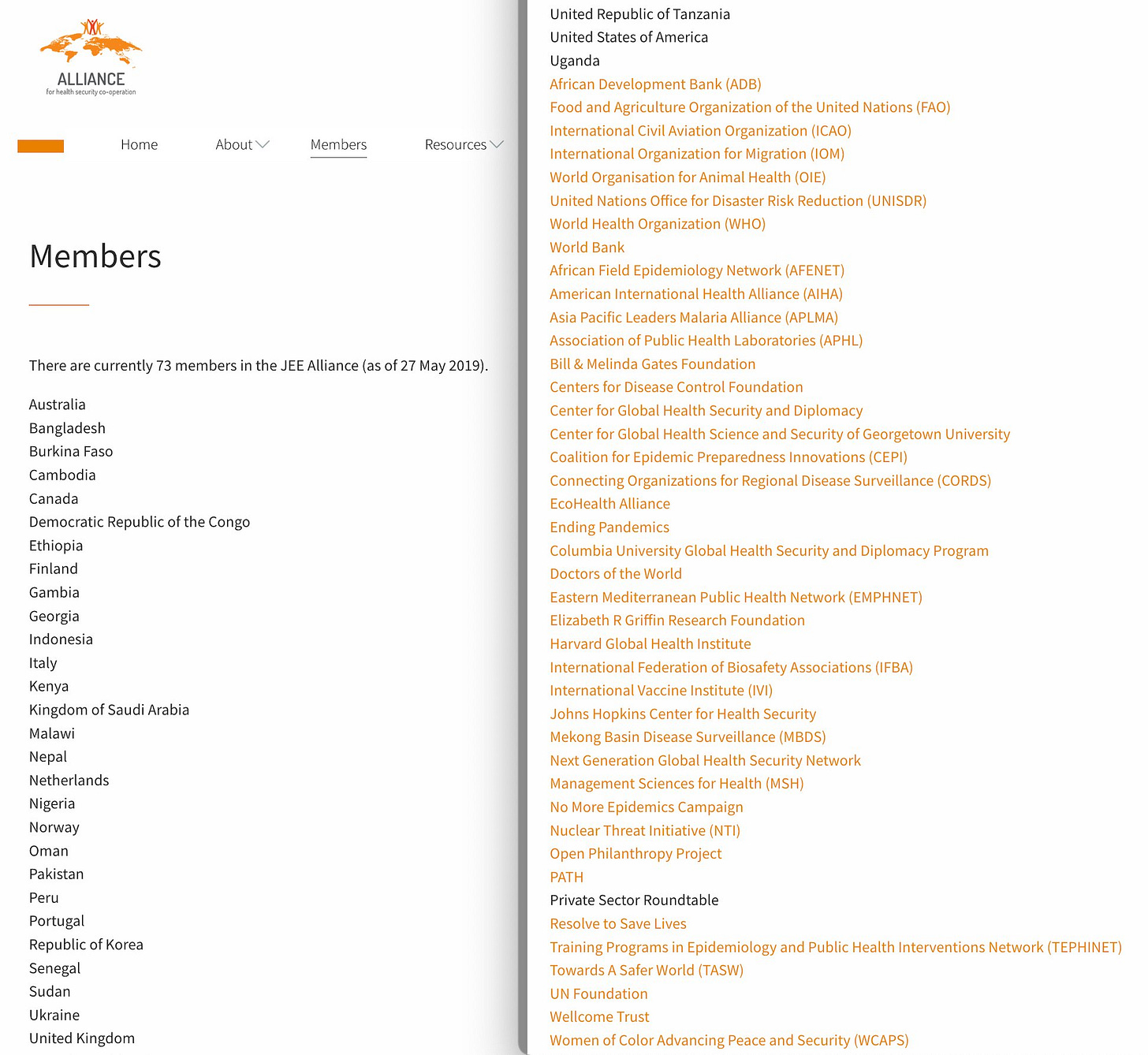The Global Health Security Agenda went live in 2014, with a stated, outlined vision - ‘Toward a World Safe & Secure from Infectious Disease Threats‘
The vision breaks down into nine objectives, and three categories -
Preventing epidemics -
The strengthening of international regulatory frameworks.
The promotion of biosafety and biosecirity systems.
Reducing the impact of infectious disease outbreaks.
Detecting disease -
Real-time, networked surveillance sytems
Global information sharing
Increasing laboratory systems
Training a capable workforce
And a rapid response -
Creating a connected, global network
Improving access to medicines, including vaccines.
Does it look familiar? It should. It’s the same story again, use surveillance and vaccines to control pandemics, while uploading all surveillance data to the WHO. Also known as the One Health approach.
-
Yesterday, I penned this on ‘Integrated Disease Surveillance and Response’, an initiative which launched in Africa already in 1998. The first thing I wish to do here is latch this initiative onto the narrative, which is easily done.
Integrated Disease Surveillance and Response
In July 2001, the World Health Organisation released a document titled ‘Technical guidelines for integrated disease surveillance and response in the African region‘. And what that document clears right up, is that the global surveillance strategy has been decades in the making
The ISDR is linked to PEPFAR. Here’s Swaziland.
And here’s Malawi. I could keep up in similar fashion, but have bigger fish to fry.
As for PEPFAR, that links right up with One Health, and the Global Health Security Agenda, as this article points out.
PEPFAR
The ‘President’s Emergency Plan for AIDS Relief‘ - or ‘PEPFAR’ - was first mentioned by George W Bush in his State of the Union address in 2003. And let’s just cut to the chase, it’s not really about AIDS. - While the address is light on detail, the '2005 ‘
-
In 2004, the CDC floated another initiative, titled the ‘Global Disease Detection‘ project. I won’t make a meal out of this, as it’s yet again about labs and surveillance.
-
Now, as part of their material, the GHSA also released this somewhat more easily digestible document, which… well, is also more of the same. Except that it drags in their stated 11 Action Packages.
And these action packages can be found here. Two of said packages deals with the Real-Time Surveillance aspect, addressed below -
We see… exceedingly familiar terminology, it transpires -
Public / animal / health security means One Health / Manhattan Principles - further compounded by the tripartite being considered the contributing international organisations.
Improved communication and collaboration, which loosely means harmonisation, confirmed by the mention of ‘standards’ later on
International levels of authority means hierarchical organisation, with the WHO at the very top.
Analyse and link data relates to the data processing and uploading of data to the WHO.
Coordination relates to the global organisation.
ISDR framework = GDD = GHSA = using the so-called One Health approach.
Surveillance standards means global data compatibility.
Integrate data from different sectors = it’s not really just about health.
To ensure all WHO member nations - partners - implement to same set of standards, and to the same level of competence…. that’s where the Joint Evaluation Expert Alliance enters the frame. Their job is to assess readiness, and prepare a report with recommendations, based on findings. The nation assessed will then implement said recommendations, ensuring broadly compatible implementations.
It’s an initiative to expressly implement One Health policies in line with the International Health Regulations, and Agenda 2030.
Their members section, furthermore, is very, very interesting.
Setting aside governments, we have -
The obiquitous Gates Foundation.
The WHO, IOM, and other UN agencies.
CEPI, who pioneered the 100-days-to-create-a-vaccine initiative.
The International Vaccine Initiative, with Deborah Birx.
The Mekong Basin, which was Rockefeller’s first surveillance initiative.
The Nuclear Threat Initiative, active in relation to CORDS (surveillance).
CORDS itself (Connecting Organisations for Regional…)
Ending Pandemics, which is Mark Smolinski (ex-NTI)’s current venture.
Wellcome Trust, who with Jeremy Farrar at helm funded questionable initiatives.
… and more, including the EcoHealth Alliance, who need no further introduction.
Should you wish to know more, there’s even an exceedingly drab video here for you to watch on the topic.
-
Using the JEE Alliance framework, the UK performed a pilot implementation in 2015. In some ways, this assessment is illuminating, because every component directly ties up with the One Health narrative.
The Global Health Security Agenda is the One Health framework.
AMR served as the original reasoning to implement in policy.
Zoonotics was the Covid-19 vector of implementation.
Biosafety and security represent active measures.
Immunisation is about vaccines.
National Labs is about the laboratories that goes with the surveillance.
Real-time surveillance relates to global surveillance being real-time.
Reporting details the global database, and the hierarchy of information.
Workforce deployment is about the likes of the One Health Workforce Academy.
Emergency operations relates to the organisational structure.
Linking public health deals with the legislative process.
And the countermeasures is about stockpiles, and advance purchase orders.
The GHSA initiative is still ongoing, for the record. I could here source a range of documents to prove this point, but here is the one I chose - an Action Plan from 2021, specically. And why? Because that also loops in the Nuclear Threat Initiative, which we encountered in the article on One Health Surveillance, and CORDS.
One Health - Part 2: Rockefeller, NTI & CORDS
Let’s have a look at the ‘Jimmy and Rosalynn Carter Humanitarian Award‘. Because in the context of One Health, it’s a remarkable list of recipients. It’s not just Farrar in 2019, Piot in 2017, but Tedros received the award in 2011, Foege in 2008, and John D Rockefeller in 2001. Although those deserve attention for sure, the three I wish to highlight are
-
So to round up -
In 1998, ‘Integrated Disease Surveillance and Response’ launched in Africa. It didn’t gain a terribly large amount of traction, with the project already severely behind schedule within a few years of launch.
To correct this issue, the US launched PEPFAR in 2003, who immediately set out to construct surveillance systems, and laboratories.
In 2004, the CDC’s ‘Global Disease Detection‘ launched. This work completed in 2018. Unsure what happened thereafter with the labs and surveillance programme, but I would bet on these being rolled into another, similar program.
In 2014, the Global Health Security Agenda launched. And that’s the present status.
-
There isn’t genuinely any real difference between these initiatives. You could argue that IDSR and GDD are programs under the framework of the GHSA - but they are all still directly connected. They are one and the same thing - laboratories, surveillance, and a server with a link to the WHO’s central database. And that’s a pattern we can observe frequently -
The laboratories and surveillance - some efforts claim to target AIDS. Others target malaria. Yet even others target pneumonia, polio, influenza, or even Covid-19. The reality here is that they all carry out the same task - gathering of surveillance data - which is then transmitted to the central server at the World Health Organisation.
And for the French speaking part of Africa, Fondation Merieux carry out the same duties under the labels ‘Redisse’, ‘Oasis’, ‘Sealab‘, ‘LabMyNet‘, ‘WARDS’, ‘RESAMAD‘, ‘LABOGUI‘, and ‘RESAOLAB‘. They even have an initiative, ‘Labo2S‘, which at this stage is probably more uncertain due to it’s… er… precarious location.
The objective here is one of fragmentation for sakes of obfuscation. But progressively, these nodes of the surveillance network will gather an increasing amount of real-time data, until the day comes where there no longer is any actual legit difference between the lot. They will simply exist to carry out their duty, which is to spy on everything you do, all the time.
But they won’t tell you this - it’s the last thing they’ll ever do, because that would be honest, and they don’t do honesty. If you knew what they were up to, you would disagree, and possibly put a stop to it.
And that quite simply would threaten our democracy. Or theirs, anyway.
And speaking of which, I did a while back track down one of those wikileaks documents which went missing when Assange was taken to Belmarsh. However, the link has since expired so take it or leave it, though it did work when originally linking in tweet.
It’s an advertised job from 2017. The USAID were looking for a ‘Senior Health Systems Strengthening Advisor’ for a position in the Ivory Coast, and the expectation is for the right candidate to ‘coordinate and collaborate with other USAID/CI technical teams (One Health/Infectious Diseases, Community Health, Malaria, Health Statistics and Evaluation) and with other USG agencies that also work in these areas (e.g., Centers for Disease Control and Prevention (CDC), Department of State (DOS), Department of Defense (DOD), etc‘
It’s a job advert for a position with the One Health global surveillance state.


















